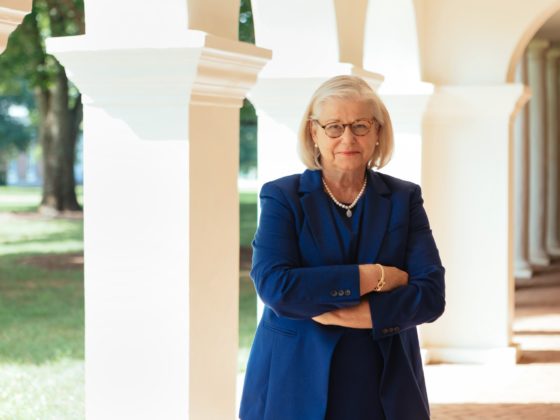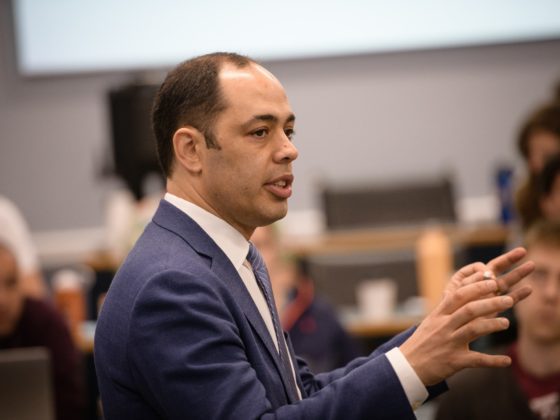Professor Anthony Palomba joined the latest installment (or episode, if you will!) of “Office Hours,” Presented by Ideas to Action. If you’re an avid media consumer — whether it’s podcasts, the latest streaming shows, movies or any other form of entertainment, this conversation is a must-listen!
Palomba teaches leadership communication and storytelling with data in the MBA program as well as management communication in the MSBA program. His teaching interests are focused on how business professionals can present data results and actionable insights to key stakeholders through storytelling. His research explores how and why audiences consume entertainment, and strives to understand how audience measurement can be enhanced to predict consumption patterns.
VIEW THE RECORDING OF THE DISCUSSION BELOW ON VIMEO
From the “Office Hours” conversation:
Q: In your role here at Darden, how do you bridge the connection between media management and communication?
Palomba: There are a few things that we can consider in this conversation. We all consume media, and this is something we forget about. If we think about what is consumed most in the United States, chances are it’s entertainment, right? It’s media, it’s books, it’s internet, it’s all of those things. We are constantly consuming different sources of expression. That’s where communication comes from: Visuals, images, audio for listening to podcasts, and things like that. I tackle that from the perspective of “How can we measure audience engagement? How can we measure fandom? How can we begin to think about how consumers gravitate toward particular products and services?” Then the conversation becomes, “How can we unlock that potential of content?” It’s really quite exciting!”
Additionally, if the next time you’re watching a movie or TV show, pay attention to how long a scene lasts, or a shot lasts. When you blink, chances are that the scene or shot will change, and that’s done on purpose. Humans tend to blink every three to five seconds, so having that kind of internal clock as you’re creating content of any kind is critical in that respect. We cover public speaking in the core curriculum leadership communication class, and we acknowledge that public speaking deals with theater, and any sort of speaking engagement (included presentations) must include a modicum some sort of sense of theatre involved – from pitch, tone and making audience eye contact. Finally, there’s also a strategy to thinking about a theme that can hook audiences, how you begin with something and how you end with something. We are consumers of stories day in and day out.
Q: Do you have a favorite case or a case that you’ve really enjoyed teaching – either in leadership communication or storytelling with data?
Palomba: I actually just wrapped up my first week in storytelling with data, and I think the students are both excited and overwhelmed, which is a good place to be — there’s a lot of chaos and fast moving pieces, but I think it’s fun. We actually discussed a case about Kate Spade, the fashion brand, in which the lesson is on visuals. When we think about visuals, it may be taking something like a client deck and then be able to connote meaning through images, and be able to control how your audience feels about something (which is kind of weird when we think about it!).
But if you go to the Kate Spade website, you’ll see that in action. You’ll see there’s not a lot of text on Kate Spade — it’s a lot of images, it’s a lot of emotions, it’s a lot of fields, all done very eloquently and very delicately. Kate Spade is of course, a fashion brand that is all about visuals, but also controls its narrative quite well. I try to impart this on the students: In the case, the Kate Spade senior management team needs to figure out if they should create a brand fusion for Kate Spade to grow. They’re addressing all these questions surrounding what to do with Kate Spade and with the data itself, right?
But students also have to think about how do we make this feel like a Kate Spade deck using visuals. “How do we make this feel so that senior management agrees the brand fusion is totally in their wheelhouse. That’s how we want to guide our clients along as we’re building decks, as we’re building stories, and as we’re being audience centric. This is something else that I emphasize quite a bit, and that case works out really well.
But, I have a lot of fun cases because I really believe that if cases are funny or fun and interesting and engaging, it really helps the learning process. Everybody’s bought in and everybody’s really stoked and excited to talk about it. I think those qualities are perhaps pieces of evidence that the class has been successful.




